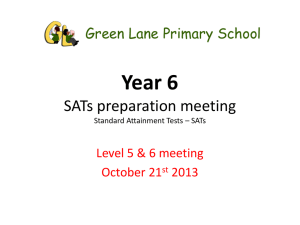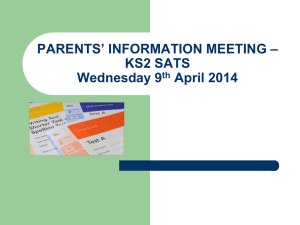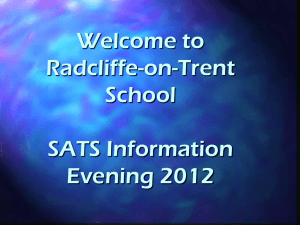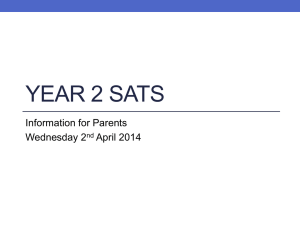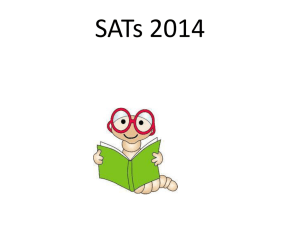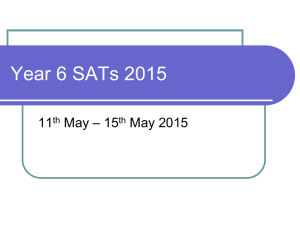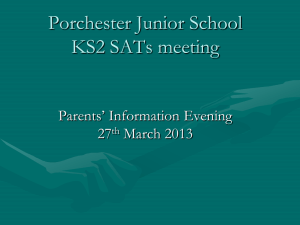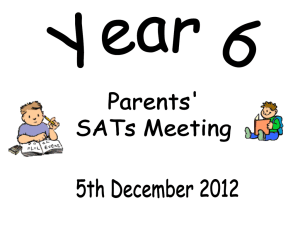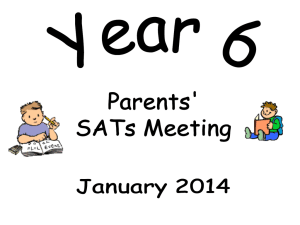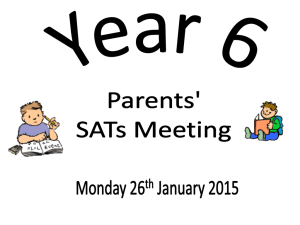MATHS SATs - Noremarsh Junior School
advertisement
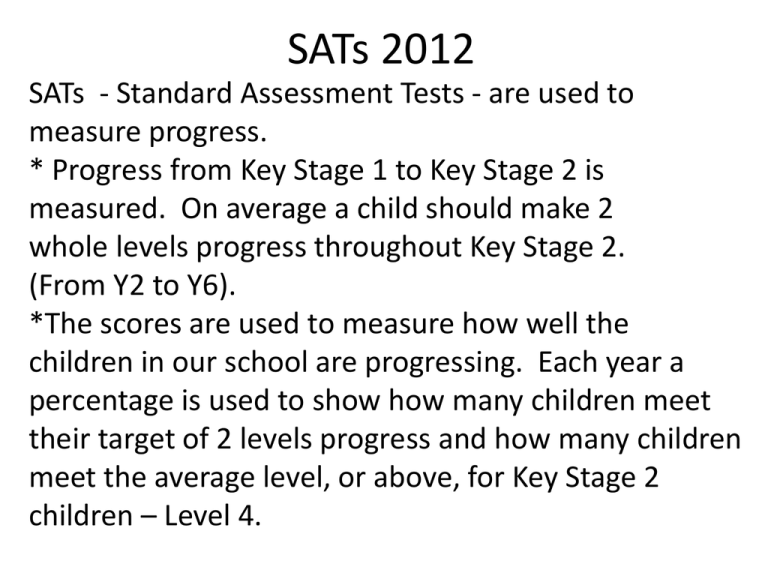
SATs 2012 SATs - Standard Assessment Tests - are used to measure progress. * Progress from Key Stage 1 to Key Stage 2 is measured. On average a child should make 2 whole levels progress throughout Key Stage 2. (From Y2 to Y6). *The scores are used to measure how well the children in our school are progressing. Each year a percentage is used to show how many children meet their target of 2 levels progress and how many children meet the average level, or above, for Key Stage 2 children – Level 4. SATs Teacher assessment is also another important part of the assessment process at Noremarsh, with children’s progress being carefully assessed by staff throughout the year. Information regarding Teacher Assessment is shared with secondary schools around Easter time, in order to prepare for the induction of Year 7 pupils. Teacher assessment levels and SAT levels are passed to secondary schools once results are returned. 2012 SATs Timetable Monday 14th May Reading Tuesday 15th May Short writing, spelling and long writing Wednesday 16th May Maths Paper A and mental test Thursday 17th May Maths Paper B Friday 18th May Science Papers A and B MATHS SATs Two written papers and a mental paper Papers A and B Written tests each 45minutes long Tests all aspects of mathematics L3 -5 Equipment: ruler, protractor, mirror, tracing paper and paper B a calculator also. Children encouraged to record jottings and show calculations. There are marks for calculations. Accurate drawing is needed to within 2mm accuracy. Some questions require explanations/reasoning as well as some straightforward computation. Each written paper (A and B) is 40% of overall mark. MATHS SATs Mental paper CD of 20 questions. Questions have 5, 10 and 15 second recall timings. Jottings allowed but time is short no time for written calculations. Some key numbers are recorded on answer sheets. Questions repeated twice each. 20% of overall maths mark. MATHS SATs – other information Some children have a reader, 1-1 adult, to assist with reading of paper - no help with maths! All children can have questions read to them if they ask – please encourage this! Time reminders given throughout test. Literacy SATs The 100 marks in the Literacy papers are allocated as follows: Reading 50 marks Writing 50 marks Longer writing (including handwriting) 31 marks Shorter writing task 12 marks Spelling 7 marks Total 100 marks Literacy SATs Reading SAT The children have 15 minutes to read through their information booklet. They can re-read bits as many times as they like during the 15 minutes. Then they have 45 minutes to answer the questions in the answer booklet. They can refer to the info booklet as much as they like during the test. A range of answer formats are needed; short one word answers for 1 mark, several line answers for up to 2 marks, longer answers for up to 3 marks and some other answers involve ticking boxes, circling answers or matching. The test focuses on the full range of aspects of reading such as decoding meaning, retrieving information, interpreting events, commenting on structure and commenting on the writer’s use of language, purpose or viewpoint. Literacy SATs Longer Writing SAT 45 minutes for the longer writing task, which includes up to 10 minutes planning time. The children do not have to use the full 10 minutes for planning and can start writing once they are ready. The task booklet contains information about the task, as well as a planning sheet with questions as prompts to help the children formulate ideas. They can refer to this as they need to during the writing time. The marks are given for sentence structure and punctuation (8 marks), text structure and organization (8 marks) and composition and effect (12 marks). Handwriting (3 marks) is also marked based on the writing in the longer task. Literacy SATs Shorter writing SAT The children have 20 minutes for the shorter writing task and can spend up to 5 minutes of this time planning. The booklet contains the task and a brief planning section, as well as a page for the children to do their short writing task. The marks are given for sentence structure, punctuation and text organization (4 marks) and composition and effect (8 marks). Literacy SATs Spelling SAT The spelling SAT consists of 20 words to spell within the context of a piece of writing. The teacher will read through the entire piece of writing, including the words to spell so that the children can hear the words read in context. The teacher then re-reads the piece of writing, stopping at the appropriate points in order for the children to spell the missing words. There is no time limit for each word, or for the entire test. Spellings can be written in upper or lower case, or a mixture of the two. There are 20 words to spell, but the number of marks available for the spelling test is 7; the marks get converted. Literacy SATs Other information There are no readers for the Literacy SATs, as the necessary parts are read to the children by the teacher. Children should be encouraged to use all of the time available and if at all possible to check their work thoroughly. Time reminders are given throughout the tests. Science SATs Two written papers on the same morning, each lasting for 45minutes. Some schools are sampled for Science – we will not know until February, however we will still take a previous test if we are not in the sample. Science SATs The two papers covers all aspects of science including: life processes– humans, plants, lifecycles and habitats materials – properties; changing and separating forces – gravity, air resistance, friction, magnetism, light and sound space. Planning experiments including fair testing is also part of these papers. Correct scientific vocabulary is required. Children need to be able to make comparative statements – e.g. the longer the pipe the lower the note. The greater the surface area the slower the fall. Both papers include interpretation of graphs and tables. Each paper is 50% of overall mark. MATHS SATs – at home Things to work on at home to help your child: Mental skills- tables, number facts, doubles and halves, finding related facts... Real life maths – shopping, cooking, decorating etc.. Mathletics and other interactive online study aids Past papers/revision guides Revision sites online. Literacy SATs Work to do at home to help your child When listening to children read, discuss the book and ask questions to help them practise retrieving information and inferring meaning. Revise the common spelling rules and patterns e.g. Plurals, -ly words, double consonants clap – clapping. Practise short pieces of writing which include accurate punctuation, a variety of sentence openers and adventurous vocabulary. Use revision guides, websites and past papers to revise the different text types e.g. persuasive writing, instructional writing, story writing. Science SATs Ways to help at home: Revise key areas of learning for each science Topic Encourage correct vocabulary and explanations of why things happen Everyday examples of science e.g. evaporation – puddles/washing drying Previous SAT papers/revision guides. Revision sites online. Paper papers • www.st-josephs-pickering.nyorks.sch.uk/past_test_papers.htm • www.emaths.co.uk • www.bbc.co.uk/schools/ks2bitesize/ • www.woodlands-junior.kent.sch.uk/revision/ • www.bgfl.org/mathsbooster • www.durham.schooljotter.com/coxhoe/Curricul um+Links • These websites are on the handout! Name: READING Score: Level: TARGET: READING Reading N 0 – 10 3 11 – 17 4 18 – 33 5 34 - 50 WRITING Spelling mark: Handwriting mark: Short writing: Long writing: Total mark: Level: TARGET: WRITING MATHS Mental: A: B: Total: Level: TARGET: SCIENCE A: B: Total: Level: MATHS Writing N 0 – 11 3 12 – 22 4 23 – 35 5 36 - 50 ENGLISH N 0 – 19 2 20 – 22 3 23 – 40 4 41 – 69 5 70 - 100 MATHS N 0 – 13 2 14 – 16 3 17 – 44 4 45 – 76 5 77 - 100 SCIENCE SCIENCE N 0 - 17 2 18 – 20 3 21 – 39 4 40 – 62 5 63+
